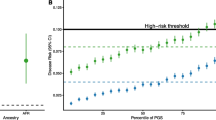Abstract
Genetic epidemiology is a young but rapidly developing discipline. Although its early years were largely dedicated to family-based research in monogenic disorders, now genetic–epidemiologic research increasingly focuses on complex, multifactorial disorders. Along with the development of the human-genome map and advances in molecular technology grows the importance of genetic–epidemiologic applications. Large-scale population-based studies, requiring close integration of genetic and epidemiologic research, determine future research in the field. In this paper, we review the basic principles underlying genetic–epidemiologic research, such as molecular genetics and familial aggregation of disease, as well as the typical study approaches of genome screening and candidate-gene studies.
Similar content being viewed by others
References
Watson JD, Crick FHC. Molecular structure of nucleic acid. A structure for deoxyribose nucleic acid. Nature 1953; 171: 737–738.
Mendel G. Versuche uber pflanzenhybriden. In: Verhandl. Naturf. Verein. Brunn 4(Abhandl.) 1866: 3–47.
Lander ES, Linton LM, Birren B, et al. Initial sequencing and analysis of the human genome. Nature 2001; 409: 860–921.
Venter JC, Adams MD, Myers EW, et al. The sequence of the human genome. Science 2001; 291: 1304–1351.
Cruts M, Van Broeckhoven C. Molecular genetics of Alzheimer' disease. Ann Med 1998; 30: 560–565.
Slooter AJ, van Duijn CM. Genetic Epidemiology of Alzheimer' disease. Epidemiol Rev 1997; 1: 107–119.
Farrer LA, Cupples LA, Haines JL, et al. Effects of age, sex, and ethnicity on the association between apolipoprotein E genotype and Alzheimer disease: A meta-analysis. JAMA 1997; 349: 1349–1356.
Rothman KJ, Greenland S. Modern Epidemiology. Philadelphia, PA: Lippincott-Raven, 1998.
Van Broeckhoven C, Backhovens H, Cruts M, et al. Mapping of a gene predisposing to early-onset Alzheimer' disease to chromosome 14q24.3. Nat Genet 1992; 2: 335–339.
Polymeropoulos MH, Lavedan C, Leroy E, et al. Mutation in the alpha-synuclein gene identified in families with Parkinson' disease. Science 1997; 276: 2045–2047.
Kitada T, Asakawa S, Hattori N, et al. Mutations in the parkin gene cause autosomal recessive juvenile parkinsonism. Nature 1998; 392: 605–608.
Leroy E, Boyer R, Auburger G, et al. The ubiquitin pathway in Parkinson' disease. Nature 1998; 395: 451–452.
Lander ES, Schork NJ. Genetic dissection of complex traits. Science 1994; 265: 2037–2048.
Lander E, Kruglyak L. Genetic dissection of complex traits: Guidelines for interpreting and reporting linkage results. Nat Genet 1995; 11: 241–247.
Risch N. Linkage strategies for genetically complex traits. Am J Hum Genet 1990; 46: 222–253.
Sherrington R, Rogaev EI, Liang Y, et al. Cloning of a gene bearing missense mutations in early-onset familial Alzheimer' disease. Nature 1995; 375: 754–760.
Rogaev EI, Sherrington R, Rogaeva EA, et al. Familial Alzheimer' disease in kindreds with missense mutations in a gene on chromosome 1 related to the Alzheimer' disease type 3 gene. Nature 1995; 376: 775–778.
Bonifati V, Rizzu P, van Baren MJ, et al. Mutations in the DJ-1 Gene Associated with Autosomal Recessive Early-Onset Parkinsonism. Science 2002; 299: 256–259.
Svetkey LP, McKeown SP, Wilson AF. Heritability of salt sensitivity in black Americans. Hypertension 1996; 28(5): 854–858.
Risch N, Merikangas K. The future of genetic studies of complex human diseases. Science 1996; 273: 1516–1517.
McCann SJ, Pond SM, James KM, Le Couteur DG. The association between polymorphisms in the cytochrome P-450 2D6 gene and Parkinson' disease: A case-control study and meta-analysis. J Neurol Sci 1997; 153: 50–53.
Tan EK, Khajavi M, Thornby JI, Nagamitsu S, Jankovic J, Ashizawa T. Variability and validity of polymorphism association studies in Parkinson' disease. Neurology 2000; 55: 533–538.
Pericak-Vance MA, Bebout JL, Gascell PC, et al. Linkage studies in familial Alzheimer' disease: Evidence for chromosome 19 linkage. Am J Hum Genet 1991; 48: 1034–1050.
Pericak-Vance MA. Linkage disequilibrium and genetic association. In: Haines J, Pericak-Vance MA, et al. Approaches to Gene Mapping in Complex Human Diseases. New York: Wiley-Liss, 1998; 323–333.
Ewens WJ, Spielman RS. The transmission/disequilibrium test: History, subdivision, admixture. Am J Hum Genet 1995; 57: 455–464.
Spielman RS, Ewens WJ. A sibship test for linkage in the presence of association: The sib transmission/disequilibrium test. Am J Hum Genet 1998; 62: 450–458.
Pritchard JK, Rosenberg NA. Use of unlinked genetic markers to detect population stratification in association studies. Am J Hum Genet 1999; 65: 220–228.
Peltonen L. Positional cloning of disease genes: Advantages of genetic isolates. Hum Hered 2000; 50: 66–75.
Stefansson H, Sigurdsson E, Steinthorsdottir V, et al. Neuregulin 1 and susceptibility to schizophrenia. Am J Hum Genet 2002; 71: 877–892.
Kristjansson K, Manolescu A, Kristinsson A, et al. Linkage of essential hypertension to chromosome 18q. Hypertension 2002; 39: 1044–1049.
Hicks AA, Petursson H, Jonsson T, et al. A susceptibility gene for late-onset idiopathic Parkinson' disease. Ann Neurol 2002; 52: 549–555.
Houwen RH, Baharloo S, Blankenship K, et al. Genome screening by searching for shared segments: Mapping a gene for benign recurrent intrahepatic cholestasis. Nat Genet 1994; 8: 380–386.
Freimer NB, Reus VI, Escamilla M, et al. An approach to investigating linkage for bipolar disorder using large Costa Rican pedigrees. Am J Med Genet 1996; 67: 254–263.
Newport MJ, Huxley CM, Huston S, et al. A mutation in the interferon-gamma-receptor gene and susceptibility to mycobacterial infection. N Engl J Med 1996; 335: 1941–1949.
Slooter AJ, Cruts M, Kalmijn S, Breteler MM, Van Broeckhoven C, van Duijn CM. Risk estimates of dementia by apolipoprotein E genotypes from a population-based incidence study: The Rotterdam Study. Arch Neur 1998; 55: 964–968.
Wang DG, Fan JB, Siao CJ, et al. Large-scale identification, mapping, and genotyping of single-nucleotide polymorphisms in the human genome. Science 1998; 280: 1077–1082.
Cheung VG, Gregg JP, Gogolin-Ewens KJ, et al. Linkage-disequilibrium mapping without genotyping. Nat Genet 1998; 18: 225–230.
Smith PG, Day NE. The design of case-control studies: The influence of confounding and interaction effects. Int J Epidemiol 1984; 13: 356–365.
Author information
Authors and Affiliations
Rights and permissions
About this article
Cite this article
Dekker, M.C., van Duijn, C.M. REVIEW: Prospects of genetic epidemiology in the 21st century. Eur J Epidemiol 18, 607–616 (2003). https://doi.org/10.1023/A:1024933620315
Issue Date:
DOI: https://doi.org/10.1023/A:1024933620315




